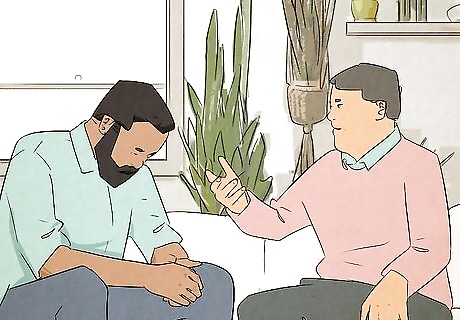
views
Holding a Conversation

Start a conversation with someone. Starting a conversation with someone can be the hardest part of communicating for some people, but it doesn’t have to be. There are some simple strategies you can use for starting a conversation with someone, even if you don’t know the person very well. Some things you might try include: Remarking on the weather or some other aspect of your surroundings. Try to say something positive, such as “What a gorgeous fall day!” or “This is my favorite café!” or “There are so many people here! How exciting!” Pay the person a compliment. If you have a way to compliment the person on something, then this is also a good option. Try saying something like, “I love your dress! It is such a beautiful color!” or “I really enjoyed your presentation!” or “Your dog is so cute!” Ask a question. Asking a question is also a great way to get a conversation started. Try asking something like, “What did you think of the keynote speech?” or “What is your favorite thing to order here?” or “Do you know how to get to the art museum?”

Master the art of small talk. In order to become a good communicator, you must be a conversationalist at the most basic level. This means you need to have a plan to navigate surface-level interactions. Learn small talk by using the match, shift, and pass back formula. Match the stride of what the other person is saying. For example, you’re standing in a long line and the person in front of you turns and says “I sure hope we aren’t waiting long. I need to pick my toddler up from daycare.” You can match the person by showing you’re listening and addressing what was said: “Oh, you have a toddler? Fun! I have two kids myself.” Shift the topic (or add more to the current topic) to keep the conversation moving in a productive direction. Let’s say the person says “Yes, my toddler is my only. She’s quite a handful.” You could respond with “I bet. Mine are older now, but I miss them at that age.” Or, you could say “My sister has a toddler. He’s in the repeating-everything-he-hears phase!” Pass back by inviting the person to keep the conversation going. You might add to either of the earlier statements. “I’m sure you have tons of adorable stories, huh?”

Consider what topics are appropriate for the situation. In some cases, sticking with small talk and neutral topics might be best, but there are times when you may consider transitioning to a deeper conversation. Consider the situation to determine what kind of discussion and topics might be appropriate. For example, if you are at a work function talking with coworkers, then you might want to stick with work-related topics and small talk. If you are at a wedding, baby shower, or some other positive event, then you might want to avoid discussing anything too deep and serious, such as death or the afterlife. However, if you are at a funeral or having coffee with a close friend, then discussing death or the afterlife might be appropriate. You might also consider how well you know and trust the person you are talking to. Do you feel that the person will keep your information confidential? Do know whether or not the person will judge you?

Know how to transition small talk into a deeper conversation. Once you have gotten better at small talk, you want to progress to transforming a surface-level discussion into something more. If you are interested in the person and think the two of you are making a connection, you can go beyond the initial introduction and surface-level discussion into something deeper. Key points to remember for going deeper in a conversation are: Be willing to show vulnerability. “You know I was really nervous to come here tonight.” Engage in self-disclosure by using connections to something the other person shared. “I can relate to what you were saying about having to look after yourself. My parents died when I was very young” or “I get what you mean about life getting in the way of your goals. I had some problems performing at school last year that caused me to repeat some classes.” Ask open-ended questions that allow for detailed answers. “What brings you here tonight?” rather than “Are you having fun?” Maintain a two-way street by balancing how much you talk with how much you listen.

Talk about things that interest the other party. If you want to become a better communicator, your focus has to be less on yourself and more on the people you’re speaking with. You wouldn’t want to go on all night about your hobbies and interests if the other parties don’t share them. Find connection points that allow you to get the other person talking. People love to talk about themselves. Show interest in your conversation partner by asking an open-ended question, giving positive feedback, or complimenting the other person. For instance, say something like “You are really good at playing guitar. What got you interested?”

Practice active listening. One of the most important skills used by great communicators is active listening. This means that you are not listening to prepare a response. Instead you are demonstrating that you hear what the other person is saying and making an effort to confirm that you understand the message before replying. The components of active listening include: Making eye contact with the speaker to show you have his or her attention Smiling or making appropriate facial expressions depending on the message Turning your body towards the speaker Minimizing distractions Clarifying to be sure you understood (“Are you saying…?”) Reflecting what was said by using emotion to verify that you understood correctly (“It sounds like you’re very upset by this situation.”) Providing feedback by sharing your thoughts or opinions on the message

End the conversation in a graceful manner. At some point the conversation will come to an end. This may be because of running out of things to discuss or simply because you need to move on with your day. To end a conversation gracefully, pay attention to the other person’s cues and then say something to officially close the conversation. Watch for cues that the conversation is over. Pay attention to the other person’s body language. If the person has gone silent and is looking around the room or starting to face away from you, then the conversation may be over. Say something to draw the conversation to a close before moving on. If the conversation seems to be over, then try saying something like, “I have to head out, but I enjoyed talking with you! Thanks for the pleasant conversation!”
Managing Nonverbal Communication

Be aware of your body language. Communication goes beyond words to how you use different elements of your body to send a message. When you are trying to communicate with others, you must take both verbal and nonverbal factors into consideration to ensure that you get your message across. In general, you want to convey open body language by orienting towards the person, keeping your arms and legs uncrossed, and making eye contact with the other person. Other things to consider would be making appropriate facial expressions and gestures to further get your message across. Space and touch can also be used to communicate. For instance, you may stand closer to a person with whom you have a more intimate relationship while you would provide ample space in business or professional settings.

Use a tone of voice appropriate for the context. Your voice is also significant in conveying your message to others. Like the saying goes: It’s not what you say, but how you say it. Taking pauses to emphasize important points, changing your volume, and speaking faster or slower depending on the context, will all determine how you come across to listeners. For example, you might use your voice to make sounds of understanding like “uh-huh” or to demonstrate contemplation like “hmm…”

Consider individual differences and preferences. When there are differences in culture, race, religion, age, or gender between speakers, these variables must be taken under consideration to ensure communication is appropriate. Know in advance the standards and expectations of the parties you are speaking with to be respectful of group differences. For example, in many cultures, it is proper for younger individuals to address senior members of a group as “sir” or “ma’am”. Keep in mind such group expectations and include these standards in your communication.

Read non-verbal communication. Just as you want to be mindful of your own nonverbal communication, it’s equally important to consider that of those you are speaking with. To become an effective communicator, watch for nonverbal signals as you talk with others. These may include: Eye contact. If someone is interested, then they will usually make eye contact with you. Facial expressions. Is the person frowning? Smiling? Seemingly bored? These expressions can help you to determine how the person might be feeling. Posture. An interested person might face you and lean in towards you, whereas an uninterested person might face away from you or lean away from you.
Learning to Assert Yourself

Have knowledge of your core needs and values. A major part of being assertive is knowing how to effectively express your needs and opinions. Nonetheless, you must first be aware of these to be able to share them with others. Gain insight into your values by making a list of your top priorities in life. This list may include examples like family, honesty, money, and recognition. Once you have made your list, rank the items from ‘most important’ to ‘least important’. Figure out your needs by thinking about what kinds of things motivate you to take positive action. At the same time, these things also have the power to cause frustration and stress if you are lacking them. Examples of needs might be belonging, control, and security among others. After you have developed your core needs and values, you can use these to help you assert yourself. For example, if you value your education and a friend wants you to cut class to help her pick out a new outfit for her date, then you might assert yourself by saying something like, “No, I can’t help you with that. My education is important to me and I don’t want to miss class.”

Gain the courage to say “no.” Being able to tell someone “no” is a very powerful factor in assertiveness, but also in confidence-building. It does not serve you to spend your life saying “yes” to every favor or expectation. This is passive behavior. Try these strategies to assert yourself and decline the requests of others. Use body language to carry your message. Make eye contact, stand with your shoulders back and chin up, and speak loudly so that the other person can hear you. Develop a formula. For example, each time you want to say “no” you can start by saying how you would love to but the request does not suit you or conflicts with existing plans. “I would love to participate in the fundraiser but I have too many obligations right now.” Refrain from apologizing. You have an innate right as a person to say “no.” Do not feel pressed to apologize, because that sends the message that you are doing something wrong.

State your opinions without attacking those of others. Be aware of what you think, feel, want, need, or prefer about various aspects of your life. When you know these things you automatically feel more confident communicating your opinions to others. To do this use “I” statements that allow you to express yourself without attacking anyone else. For instance, you might say “I really liked the movie. The main character was so cool to me.” Then, ask for the opinion of someone else and listen to it without interrupting or expressing disagreement.

Accept compliments and criticism graciously. This may seem contrary to assertiveness, but it’s not. Assertive people understand that their ideas and opinions are just as important as everybody else’s. Also, they are aware that opinions are only opinions, not facts. Therefore, if someone shares feedback about you, you can have the inner confidence to accept it graciously without dismissing a compliment or becoming upset by criticism.

Use compromise sensibly. In most cases where two people disagree, there is some wiggle room. When you encounter a situation where your opinion or idea differs from someone else’s, try to find the common ground. Look for ways you can find mutual understanding. For example, consider how much you care about the issue at hand. If you don’t care as much as the other person, it may be easier for you to bend to their side of things.




















Comments
0 comment